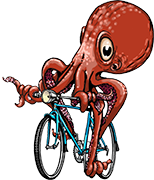|
Of all the bike threads now in TGO, this is necessarily the most pragmatic. In the previous thread, there was a growing contigent of e-bike riders. This thread can still support ebikes for their cycling components, but now there's a dedicated e-bike thread. This thread is about buying, riding, maintaining, and upgrading bikes for commuting or transportation. For other sweet forms of cycling, see the bottom of this OP. Credit to last OP for much of the content here: https://forums.somethingawful.com/showthread.php?threadid=3627612 With time and effort, you may one day attain as much steaz as this rider:  FAQs
Help Me Find a Bike Questionnaire  Crazy goons with mad Craigslist Skills are waiting to help you out. Crazy goons with mad Craigslist Skills are waiting to help you out.  If you want help with buying a bike, include the following in your post: Location: Height: Inseam: Budget: Length of commute: Terrain: Link to local Craigslist or equivalent (if looking for second hand): Measure your inseam like this. Do not post your pants inseam. This is critical to finding a bike that fits you.  General guidance on buying a bike A major source of contention between experienced cyclists and newbies looking for advice is how much a bike costs. You can get a nice or new bike for $400-500, not including accessories. You can get a good deal on a used bike for $250-300. Thread regulars enjoy trying to find these deals for you on Craigslist. You will not enjoy or be able to maintain a new bike that costs $150. This is the kind of bike you might find at Walmart. None of the components are meant to last, nor can you buy cheap replacements. The bike will have a $5 brake on it, that once it quickly decomposes, you'll need to replace with a $20 brake. And so on. This video, while terribly lit, walks you through an extremely comprehensive checklist for looking over a potential used bike purchase: https://www.youtube.com/watch?v=z0hEfwWg8vY If you follow no other advice in this thread, then heed this: don't buy a used $100 bike with a suspension fork. Rigid is the way to go in almost all cases for commuting. Testimonials Posts from people who went there and did it, who managed to start bike commuting: Leng's big long post with nice auxiliary advice AreWeDrunkYet on opting to wear normal clothes and prioritizing carrying little iospace with tips for wintry commuting https://. https://. https://. https://. Roadside repair The #1 unexpected inconvenience you'll run into with your bike is flat tires. You gotta learn how to replace a punctured inner tube if you wanna commute. If you carry no other parts on you, at least take these: - inner tube - tire levers - hand pump - tire patch You could carry only tire levers, or for a couple more ounces, a more capable multi-tool. My personal recommendation: https://www.amazon.com/Topeak-Hexus-X-Multi-Tool/dp/B078HTKKBY The Hexus X prioritizes versatility (spoke wrenches, chain tool, torx heads) over precision (the hex keys are kinda sloppy) or efficacy (the levers are pretty small). For a slightly heavier, better, and pricier solution, you could go Pedro's Levers + Crank Bros M19. For pumps, I'd say get one with a little base so you can step on it and pump against the floor (instead of your other hand or own body): https://www.amazon.com/Topeak-Road-Morph-Mini-Pump/dp/B07C3TJ8MZ A hose is a must for not having to hold the pump head perfectly still relative to the rim. Leave the ultra-compact stuff for sport rides. Maintaining your bike At least once a week, do your ABCs: Air -- check that your tires have enough air. A floor pump at home ($40-50 for a nice one) is a great investment. You don't want your tires rock hard, as that negates their ability to deform over road bumps and smooth your ride. Picture rolling at speed over a 2x4 -- you want enough air in your tire so that it keeps the sharp edge from pushing into your rim. If the rim hits the obstacle, you could damage the rim or cut into your inner tube or tire, getting a flat. Here's a detailed chart for various weights vs tire sizes. Pretty quickly, you'll develop a sense for proper inflation just by squeezing the tire after you pump it up to the correct psi. Brakes -- check that you have enough pull in your levers to stop you, and that your brake pads haven't worn down to the metal. Adjust your brakes as necessary (there are tons of good tutorial videos), or get a bike shop to do it for you. If you hear any grinding when you brake, check for grit/debris embedded in your brake pads. Chain -- lube your chain, regularly, and definitely if your hear squeaking. Even if you don't do this every week, try to do this every few weeks. Chains loosen as they wear out, and no longer mesh well with your cogs/rings, causing those to wear out faster. You should replace the chain before it gets stretched out to preserve the more expensive components. There's no formula for how long chains last -- it's largely a function of how much rain/grit you ride through and the model of chain. Figure worst case, several hundred miles, and best case, a few thousand miles. For anything more complicated, bike repair thread. Long-term maintenance Things also slowly wear out or get out of tune: - brake pads - tires - cassettes - derailleurs - brake/shift cables - cassettes / bottom brackets / chainrings - rim brake tracks All of these can be fixed easily or replaced at a bike shop. Many can also be fixed at home once you learn how. However, the point of saying all this is to emphasize that you should budget some money, say $100 a year, to keep your bike running. If you're starting out from scratch (meaning you didn't regularly ride bikes before), it may be hard to know what's a sudden change that indicates a failure/break, and what's a result of wear / drift that can be addressed by tuning or replacing a wear item. Don't be paranoid, but don't ignore things that you concretely notice. If you're new, bring the bike into a shop and describe the change or symptom. As you get more familiar with bikes, your ability to diagnose (and fix!) issues will grow, and you'll need to rely less and less on prememptive checkups or reactive trips to the shop. Alternatives to normal Local Bike Shopes are Bike Collectives/Cooperatives. These are weird and wonderful places run by punky/hippyish people dedicated to fixing up bikes and helping people fix up their own bikes, with a strong emphasis on recycling and reuse. Bike collectives tend to have a full range of tools to do anything you need to on your bike, as well as bins full of used parts that will save you money when it comes to repairs. They also often have knowledgeable volunteers and occasionally paid staff who will teach you bike repair skills. There is a fairly up-to-date list of bike collectives here: http://www.bikecollectives.org/wiki/index.php?title=Community_Bicycle_Organizations Links More riding that you can shake a hand pump at: Bike Repair, for more detailed repair questions, issues, and puzzles Bicycle Touring: Seeing the world via pedal power General Bicycle Megathread Mountain Bikes Catching the Spirit of Gravel: a thread e-Bikes Competitive Cycling - Fast is Fun, and we have the most fun Biking the Great Below are more posts covering equipment and safety. kimbo305 fucked around with this message at 20:08 on Mar 11, 2024 |
|
|
|

|
| # ? Apr 16, 2024 22:00 |
|
Riding Safety Some quick tips, borrowed from a riding course Leng attended.  The below is adapted from a writeup I did for a friend who wanted to start bike commuting (and did for a month until she moved an impractical distance for her inexperience to take on). The bulk of this focuses on riding on roads shared with cars, with a small bit of general riding skills at the end. Unlike self defense advice, which places "avoid dangerous situations" as the highest strategy, bike commuting strategy for many (maybe most in the US) riders cannot avoid addressing sharing the road infrastructure with 4000lb vehicles driven by the average public motorist. You should consider yourself lucky if you're able to ride any part of your commute on dedicated bike paths or at least no-car roads. For me, I can ride 4.5mi all on roads, or 3mi on road, 3mi on Multi-Use Path. If I'm feeling slow or less focused, I usually go for the longer, slower, but safer option. ======================================================================================= Navigation and route planning [this section was written with Boston in mind, which is relatively good for the US in terms of bike infrastructure and commuting culture] Google Maps makes decent suggestions for getting on bike paths and roads with bike lanes, though it is not perfect. I would generally pick busier roads with dedicated bike lanes over quieter roads that do not have bike lanes. Drivers usually begrudgingly accommodate cyclists when theyíre in bike lanes (thereís strength in numbers, too [obviously locale-dependent]), whereas they feel more inconvenienced when passing a cyclist on a normal street. If you are riding a route regularly, get a feel for the overall traffic picture. Are there certain intersections that are busy / dangerous? If so, explore alternate routes. At the very beginning or end of your trip, if it would be majorly convenient to go on the sidewalk for half a block, just walk your bike the rest of the way. I cannot stop you if you coast up to your door/garage. Other cyclists There will be other cyclists out there, and usually they arenít a factor, because bikes are so much smaller than cars and occupy less space even when theyíre closer to you. Two rules of etiquette: 1. At traffic lights, stay in single file and donít try to move past other stopped cyclists. Other cyclists will do this to you, and theyíre just being rude. 2. Give wide berth when passing slower cyclists. I generally donít call out or ring my bell when making a pass as long as I have several feet of space. Certainly you can, but reactions will vary and might not actually help your pass. Donít pass someone on the right. Road conditions There will be times when there is a big crack, pothole, or other hazard in your path. Donít stare down at the ground 10ft in front of you, but frequently check what youíll be rolling over in a few secondsí time. When you see a hazard, slow down and figure out whether you can pass around on the left or right, or if you can roll over it. Avoiding debris and potholes is ideal to protect your tires. Avoiding larger potholes is good so you donít get steered/bucked off your line. Specific traffic scenarios By far, the most common adverse interactions with cars come when you are traveling in a straight line on the right side of the road and a driver pulls across your path, either to stop or to make a right turn. Whenever a car passes you slowly or is traveling at your speed very close in front of you, you should be on alert to brake in case they do pull over and stop. This awareness and anticipation is the core skill for bike commuting. Right hook From the above scenario, if a car is on your left and goes to turn right, thatís called a right hook. Illustration:  [source: http://www.illinoisbicyclelaw.com/p/types-of-bicycle-accidents.html] The driver, not paying attention, thinks the path is clear and turns right in front of the cyclist, who needs to brake, veer, or run into the car. The most important thing to do when a car looks like it could be turning right or pulling over is not to stay to its right, but to get behind it. Thus, you avoid getting right hooked and make yourself more visible to cars and bikes behind you. This is illustrated by the right column below:  When you are not in a bike lane, the concept of getting behind a car is called taking the lane -- behaving like the fully entitled road user that you are. Taking the lane is a crucial maneuver when interoperating with cars taking right turns. I cannot stress enough that taking the lane is the correct move over slowing down and staying to the right of the turning/stopping car. Even if youíre looking to turn right at the same intersection, if there is no turning bike lane, you are better served taking the lane and turning behind the turning car. Back to the picture -- look at the center column. This maneuver is a natural extension of taking the lane. In the case that the right-turning car is slow or stuck in the intersection from crossing pedestrians or other traffic, you might (in a car) pull out to the left a bit and pass around the turning car. You can do the same on a bike, with the same precautions -- that there is no one behind you and there is room on the road to pass on the left. You might find yourself part of a line of bikes passing a car this way. This is fine; just go with the flow. Other times, in tight space, there will be a car stuck behind you unable to pass to the left. Make sure they are not moving to pass, and then pass on the left. More taking the lane discussion Letís say you come to an intersection that has a right turn lane and a going straight lane. If youíre headed straight, youíll need to avoid being stuck on the far right of the road, which will herd you into the right turn lane. By planning ahead, you can take the lane ahead of the intersection and then get behind the traffic going straight, avoiding any cars turning right into you.  In this illustration, red is the bad path, and green is taking the lane. Note that in the picture, the 2nd lane of travel is both straight and right-turn. This again illustrates the value of taking the lane -- by being fully behind a car, you cannot get right hooked by it. Sometimes you will be biking on a road with street parking, with cars sparsely lined on the road. You might be tempted to pull over into any gaps where there arenít parked cars and let cars pass you. You can think of pulling over into a gap as a form of yielding the lane. You donít want to do this. While there is a certain mental discomfort with holding up a car that is having trouble passing you, it is more important that you donít trap yourself. Two things could happen if you pull into the gap: - Cars will underestimate how much space they need to give you when youíre pulled over, so when you pull left to get around a parked car blocking you, a car will pass dangerously close. Closer than if youíd stayed in your lane. - The flow of cars is so heavy that you canít easily pull back out onto the lane you had made for yourself. So donít be tempted by gaps in parked cars -- keep going straight and set firm expectations to cars behind you that you arenít going anywhere. Left hook This is a relatively uncommon, but still dangerous scenario. It can arise with stop-and-go traffic in both directions, so don't let your guard down if cars are slow.  In stop-and-go, a car going your way may want to let a left turning car coming the other way through, even though youíre traveling through in your lane. In traffic, pay attention to when cars on your left suddenly stop. This could be yielding to pedestrians at (or not at) a crosswalk or letting an oncoming car turn in front. In either case, slow down and use caution. Parked cars and getting doored Lots of streets allow for street parking. In stopped traffic, it can be useful to roll up to the light. When doing so, pay attention to cars that have flashers on or drivers in the car. In these cases, the slower youíre going, the less likely youíll run into an opening door. When street traffic is moving, try to give yourself as much space from parked cars as you can without sticking too far into traffic. Making left turns This is extremely situationally dependent. On a bright day, on a slow street, you should be able to easily look back, see that thereís no cars coming behind you, and take a left turn at an unsignalled intersection. In other conditions, you may choose not to do so because you canít easily check traffic behind you. In these cases, you could always stop at the intersection and walk your bike across. At a busy signalled intersection, you make a hook turn, where you bike past your left turn, stop in the lane of traffic going in the direction of that left turn, and then wait for the light to change. Details: http://cycleguide.dk/2010/05/how-to-do-a-hook-turn/ A few intersections are painted for hook turns, though you donít have to use them. When you have a protected left turn lane and a green arrow, you should take the lane and make sure the car in front of you is not going to go rogue and go straight instead of turning left. Roundabouts I generally donít recommend riding through an unsignalled roundabout unless you are a pretty fast rider and can more or less keep up with cars slowly driving around the roundabout. Walk on crosswalks as needed. Other scenarios A lot of other less common scenarios are documented here: https://bicyclesafe.com/ Riding skill Knowing how to negotiate cars and various traffic scenarios is important, but being comfortable on the bike can make bike commuting a lot less stressful. A lot of this will only come with practice, though you donít have to ride on the street to get better here. Looking around You should be able to look 180deg across your front with only slight turns of your head. Use common sense and adjust accordingly if you see a situation approaching. Looking back If there is a stopped car or road hazard or pedestrian walking into the street ahead of you, you want to look back just to assess what kind of car traffic is behind you. Looking back momentarily while riding straight ahead isnít completely natural, especially if you have a stiff neck or arenít flexible. This is something I would practice a lot. You can mount a mirror on your helmet or handlebars, but a mirror should not be regarded as granting you the same situational awareness as looking back. Riding slowly Having the ability to ride close to walking speed gives you confidence that youíre not going to fall over if you suddenly have to come to a stop. Basically, if youíre able to creep along at 2mph and then have to put your feet down and stand off the bike, thatís a lot more comfortable than not being steady below 5mph and having to sort of hop off the bike as you drop below that speed. In this way, any time something unusual arises, you can slow way down and assess from your bike, instead of standing still. Riding slow means you can sometimes slowly pedal the bike around something instead of awkwardly velocipeding the bike around. A secondary benefit is that you can start timing traffic lights on your regular route, saving yourself a lot of energy and hassle from dismounting and remounting the bike. kimbo305 fucked around with this message at 22:55 on Jul 17, 2023 |
|
|
|
Equipment Helmets There are riding infrastructures and bike cultures out there that do not normalize wearing helmets. In this fairly US-centric thread, you'll hear mostly advising to wear helmets as common sense, with plenty of pretty vituperative dissent. I can no more prevent these inevitable debates than I can prevent you from riding without a helmet. Helmets are fairly cheap (or expensive, if you like) insurance for certain kinds of crashes you can have. They won't protect the rest of your body from huge wrecks, but they can save your noggin if a wheel slips out and you slam the deck. Current US testing standards for helmets (CPSC) aren't well correlated to the kinds of crashes currently understood to commonly cause head injury. One of the tests is to put a metal head in the helmet, invert, and drop it from several feet. Most crashes have some degree of rotation, with the head swinging at the end of the torso. The European standard is CEN. If you want a detailed breakdown comparing standards, here you go: https://helmets.org/stdcomp.htm Virginia Tech is accumulating bike crash data and applying it to their modeling for frequency of types of crashes and damage incurred. This program is an offshoot of their similar work for football helmets protecting against concussions. VT has its own crash standards to match their model, and their own ratings: https://www.helmet.beam.vt.edu/bicycle-helmet-ratings.html If you click on the <$100 tab, there's plenty of 5 star helmets, so go wild. Some helmet manufacturers take crash safety very seriously (devising their own crash standards testing), and bake some of the R&D and materials costs into their prices. But for the most part, $300 helmets are that expensive because of nicer materials that touch your head and style. As with most items that fit your body, you'll do best to try helmets on in a store. A helmet needs to fit your head decently -- not have any big gaps, but come down low enough to cover your cranium. When cinched snugly, it shouldn't rotate over your head. If it did that in a crash, it wouldn't protect you. On the other hand, you don't want a helmet that pinches your head and hurts after riding for a while. There are plenty of counterfeit helmets that you might see on Amazon or eBay for $30 that will not pass the crash tests; don't buy these. Clothing When starting out, wear what you want, but be aware that the effort of cycling means you can dress cooler than you would if you were walking somewhere. If youíre wearing anything loose by your ankles, make sure you roll it up or strap it down so it doesnít run into the chainrings. I have no direct experience, but if youíre wearing a skirt, you might use a coin and rubber band to convert the skirt into skorts to make it easier to get on and off and pedal around. People sweat to different degrees. Some may be able to pedal to work even in the summer without sweating so much that they need to shower/change. Others will have to invest not only in the having extra sets of clothing, but also add that time into their commute. Pedaling, Saddles, and You Bike fit is important. The more miles or hours you ride, the more important it is. You can wear anything and ride any bike for a few minutes. But as riding time builds up, you want your bike and your gear to be fully refined to work for you. Let's start with bike fit. 3 fundamentals: 1. you want your saddle height to work for your leg length. Take the inseam from the OP, multiply by 0.883, and that's the distance from the center of the cranks to the top of the saddle. If you're new to biking, setting that from the get go might feel much higher / more stretched out than you like. It's ok to start a couple cm low, get used to other aspects of riding, and then come back and fine tune your height. 99% of very casual riders you see out there have their seat too low. 2. you want your hands to be not too far, not too cramped. The more weight your hands support, the less weight on your feet and more crucially, your taint area. However, plenty of commuter bikes are very upright and give people no problems. Handlebar width ought to reflect your shoulder width, but it can be kinda fudged for commuting, which shouldn't be razor's edge all the time where you need perfect handling. NOTE: adjusting handlebar position can be somewhat easy or rather involved, depending on your bike's componentry. 3. you want to avoid saddles that are too puffy, as all that padding will push up against your soft bits, possibly cutting off blood supply, which is bad. Ideally, you want a less padded saddle that lets you place just your sitbones in contact with the saddle surface. Some illustrative pelvis modeling:   Of course, there's flesh between the sitbones and the saddle, but far less so than in other areas around your butt. Getting used to any saddle when you start out takes some days/weeks to work up to, so don't be surprised if figuring out what saddle works for you is a journey. But also don't be satisfied with a saddle that hurts, doesn't feel right, or worst, makes you go numb. In my own opinion, you can ride in any clothes for up to 5-7 miles. To tie this back to clothing -- past a certain distance/duration, you might feel more comfortable in cycling shorts. Normal clothes can have fabric or seams that chafe you a lot at the saddle contact points. Additionally, they might not stretch well and can hinder your pedaling some. Not enough that you can't ride, but it can get annoying. You could also simply test around and see which wardrobe items work best for you while cycling. I switched all of my jeans to a few brands that work for me. Rain and Snow Skip if you live in a nice arid climate. In general, I check the forecast a couple times a day, more frequently if itís going to rain. Even if you donít plan to ride in the rain, you still need to know when to avoid it. If you are going to commute in the rain, you need full coverage fenders. A quick example:  Most hybrid/commuting bikes have mountings to let you add fenders. Specific fender recommendations should be a common thread topic. Fenders protect your body above the knees from water spray and gross road dirt in the water. Below the knees, if youíre rolling through standing water, you might still get splashed on a lot. Bring a spare set of socks and maybe shoes. Depending on how much itís raining, you might need to accept that youíre getting soaked. This is fine in warm weather, but pretty lovely in the fall and winter. Bring more change of clothes as needed. A waterproof jacket helps, but you may still get water coming in at the neck and up the sleeves. You might also have trouble fitting a hood under your helmet. Compared to rain, snow is generally more of a problem on the ground than when itís falling, though visibility can be similarly reduced in heavy snow. Generally, bike lanes are plowed/cleared at the same time as car lanes, but sometimes a day behind. Slushy snow is gross but doesnít really present a safety issue. Ice is of course dangerous and needs to be treated with utmost care if it might form in places on your commute. There are studded bike tires for riding on ice, but I find them to be really uncomfortable when not riding on ice and packed snow. The number of days where I see ice in Boston are few enough that I donít mount studded tires any more. Lights Lights are safety essentials in northern latitudes with short winter days. Here's where I editorialize the most -- I recommend only one battery-powered light for regular night time commuting, the B&M IXON IQ Premium. Hereís its beam pattern:  Itís not super bright, but itís got a fairly wide beam, so if you see an obstacle, you can also see whatís around it to plan how to navigate around it. Additionally, it has a sharp cutoff at the top, so that light doesnít bleed forward into the eyes of oncoming drivers. Blinking white front lights are extremely distracting and should not be used. On a road without streetlamps, the bright setting is more than enough to ride at normal speeds. It uses normal AA batteries, so itís easy to carry spares. It lasts ~4 hours on bright mode, and ~16 hours on dim mode. This is an $80 light, but I would say itís worth it. The housing and plastic build quality isn't even that great, but the lighting itself is superb. B&M do make a light that's even brighter and more expensive, but I've never used it. I have 3 IXON IQ Premiums. There are plenty of reasonable lights out there that can work for your needs. I'm just advising that the longer you're riding at night, the more dollars it's worth putting into the light. Blinking red lights can be distracting if theyíre not diffuse (frosted) or have ramping brightness change. I recommend pulsing lights so that youíre always in the visual field of the driver, instead of sometimes disappearing. I recommend the Nite-Ize TwistList. Buy a couple so you have a spare. It uses CR2016 coin batteries. Carrying things There are a million different options. If youíre just carrying a laptop, a backpack or messenger bag could be fine. Bring a plastic bag if it isnít waterproof. More clothes -- maybe a waterproof backpack. There are a variety of basket/rack solutions. Again, this should be an active thread topic. Locking Long term parking your bike outside is a risk that can only be partly mitigated by a good lock. If at all possible, park in a secured bike cage or attended parking garage. The point of a lock is to discourage the thief from targeting your bike. Maybe theyíll go for another bike thatís not locked up as well, or with a crappy cable lock. Maybe theyíll decide itís not worth the time to cut through the lock. If you must park outside, pick a good bike rack to lock to. One that has concrete poured around the pole, if possible, instead of 4 bolts holding it to brick or cement, which can easily be yanked out. Try to get a U-lock. The folding link locks aren't as good, and braided cable locks are very insecure (and yet I've used them for some lockups). Yes, you need to find a place to store the thing, either a backpack or somewhere on the bike. The most secure method:  Only needs one big U-lock. I have never done this. My bike has never been worth so much to me that I wanted to spend the extra 30s setting up the front wheel. A very secure method:  Can be a smaller U-lock. You have U-lock coverage for everything but the front wheel, and a cable lock that would still take 30s to saw through to get the front wheel. The less secure variant to this would be to not have the cable lock. Faster to lock/unlock. Almost equal level of security:  Just need the U-lock Here, you secure the front wheel and sacrifice the rear. Which takes maybe 5 more seconds to take off than the front wheel. Only the rear wheel, though the rear triangle:  If they don't cut the U-lock, they can destroy the frame to get your rear wheel, or your rear wheel to get everything else. Likely, this kind of loss will deter thieves looking to steal your bike for value. Acceptable for quick trips into a store -- just locking the frame:  If they don't cut the U-lock, they can leave you with just the frame, or they can gently caress up your day by destroying the frame, too, for ??? reasons. Now some bad lockups --  Unhook the front wheel, take the rest of the bike (maybe wheelie away into the sunset).  Cut the cable lock and ride off, or come back with a truck.  Cut the cable lock or just pull it up around the signage.  Loosen the seat post, remove lock, put back seat post, ride off. More examples: http://www.poorlylockedbikes.com/ Match your locking to the risk -- how long you're parked or how bad bike theft is in the area. No U-lock can prevent bike theft. kimbo305 fucked around with this message at 22:18 on Nov 14, 2021 |
|
|
|
Bike commuting in the winter in one of the coldest cities in North America can be done. No you dont need a fatbike. People do it on 26" mtbs with normal tires. Single speeds and even fixies are also great in the winter. Studded tires are better and available in all sizes. Fenders are reeeeal nice. Dress in layers. Wool is magic, synthetics are good. Cotton kills. If your head gets cold even with a hat under it tape up the vents on your helmet with duct tape. If your hands gets cold you can get cheap handlebar mitts from Amazon or expensive ones from Revelate or 45nrth Get lights with high capacity batteries. The cold saps their power like an icy vampire. Know your cities plowing schedule. If they have published priority 1 streets use those on snow days. Take your lane. The curb is especially treacherous in the winter. Enjoy yourself. There's nothing like riding in the almost total silence of a winter road with a thin fresh layer of snow.
|
|
|
|
kimbo305 posted:Calling all posters who got their start in this thread: please consider writing a blurb on how you managed to get bike commuting to work for you in the new thread: Glad to share, especially since I got guidance from goons when I was getting started. In the before times when people still went to offices, I did about 5 miles in each direction on suburban streets. Actually going on the streets would be suicidal (50 mph speed limit in places), but the sidewalks are basically deserted so there's no issue riding there. This is in the southern US and I didn't want to deal with showering or changing in the office, so the ride into the office was a leisurely 25-30 minutes but going home was about 20 since sweating didn't matter. I never rode in rain or the dark, so the bike was (is) just an 80s steel racing bike with 28mm road tires and no accessories other than a bell - which goons helped me find on craiglist in 2008 for like $300, and is still going strong. Overall it was about an extra half hour of commuting per day compared to driving, more than worth it for the built-in exercise that I need anyway. e: Oh, and my biggest takeaway from getting settled into the commute was figuring out how to carry as little as possible. Not taking a laptop back and forth meant dropping the backpack which was huge for comfort, and since theft isn't a concern at the bike rack at work a thin gun cable lock* that wraps around the seat post when not in use is plenty and way less of a hassle than a u-lock. * 
AreWeDrunkYet fucked around with this message at 03:50 on Jul 26, 2020 |
|
|
|
My current bike commute is riding the rollers for 30 minutes before work from home. It loving sucks. Any tips?
|
|
|
|
get a job in healthcare and not only will you have to physically come in to work you'll be doing it at weird rear end hours where nobody else is out on the road
|
|
|
|
Very good OP, just need a mod to fix the thread tag. I hope once the pandemic is over there's an influx of people switching to cycling as their primary means of transportation with the sweet new bikes they got during lockdown.AreWeDrunkYet posted:e: Oh, and my biggest takeaway from getting settled into the commute was figuring out how to carry as little as possible. Not taking a laptop back and forth meant dropping the backpack which was huge for comfort, and since theft isn't a concern at the bike rack at work a thin gun cable lock* that wraps around the seat post when not in use is plenty and way less of a hassle than a u-lock. I'd never lock up without my Abus Granit X-Plus, but I have a bunch of those locks that came with some of my guns that I never use (because I have my own locks that are keyed alike). I wonder if it's small enough to install unnoticed on the front brake rotor, and if a thief trying to haul rear end out of there can build up enough momentum to do an endo. If my bike ever got stolen I think it'd cheer me up a little to know that they got hurt in the process. Just need to make sure I never forget to remove it myself before heading off.
|
|
|
|
Coxswain Balls posted:I'd never lock up without my Abus Granit X-Plus... quote:Product Dimensions: 1.4 x 6.9 x 11.6 inches ; 3.43 pounds Ouch.
|
|
|
|
we could all probably stand to lose that much weight anyway
|
|
|
|
bicievino posted:My current bike commute is riding the rollers for 30 minutes before work from home. Be more essential.
|
|
|
|
AreWeDrunkYet posted:Ouch. The bikes I use for touring and commuting are 40-50 pounds so I don't think it's a big deal. I'm of the opinion that weight is the least of my concerns on an everyday errand and getting around bike. The vast majority of the bikes I saw in Japan were mamacharis so I know I'm not in the minority.   For what it's worth the Granit-X is the lightest lock in its strength class, with mine measuring at 3.2lbs. LockPickingLawyer reviewed it recently and recommended it, which is some very high praise. https://www.youtube.com/watch?v=PtdiO1ZiiXk
|
|
|
|
Found this typo in the OP:kimbo305 posted:
|
|
|
|
You most definitely need fenders on your commuter, and mosdef not on anything else.
|
|
|
|
Good fenders own.
|
|
|
|
Bad fenders suck but they still suck less than gutter water and goose poo in the face.
|
|
|
|
I got rid of my leased car in May, and for the first time in almost two decades, have been carless since. Been relying on my ebike for work commute (on the rare days I'm not WFH anyway), and a trailer in the last month for big hauls, and it's been hugely successful - indeed, even fun. Getting a little better on the fitness front too, even with the motor doing a lot of cheating for me   Driving sucks poo; bikes are cool and good. It's great to live in a community with some bicycle infrastructure. 
Ciaphas fucked around with this message at 16:26 on Jul 26, 2020 |
|
|
|
evil_bunnY posted:You most definitely need fenders on your commuter, and mosdef not on anything else. Head to toe waterproofs is what I used for years. In Dublin, Ireland, there were plenty of days when fenders wouldn't do half the job needed.
|
|
|
|
Pre-Quar I had just moved and started a new gig that was 15 minutes away by bike. I was extremely happy
|
|
|
|
alanthecat posted:Head to toe waterproofs is what I used for years. In Dublin, Ireland, there were plenty of days when fenders wouldn't do half the job needed.
|
|
|
|
does anyone make a reasonably-priced 27.2 seat post that will take a standard M8 or M10 security torx saddle bolt? my gf's bike has a stocking seat post collar, but some rear end in a top hat stole her saddle and the factory bolt is some weird bullshit so the standard bolts I've ordered won't fit the factory saddle nut.
|
|
|
 Iíve bike commuted a few times in the last ten years, but a recent move to Halifax and the amazing weather and increased cost of driving drove my wife and me to use the bikes for commuting at all times. There was no work so we moved to Edmonton and sold our car and now we just bike + rideshare for all our transportation needs. The rideshare works out to be like 1-3 hours a month so itís a lot of bike riding and there are no hills so thatís fine and cool and easy. Sometimes I run sprints out of the river valley just so Iím not rendered totally impotent by the flatness.
|
|
|
|
|
What gloves do people go with in the winter? I've gotten some thick bike gloves but they aren't up the task once temperatures get below 40F, though that's usually my only body part that complains.
|
|
|
|
Twobirds posted:What gloves do people go with in the winter? I've gotten some thick bike gloves but they aren't up the task once temperatures get below 40F, though that's usually my only body part that complains. At around those temps I can get by with either some cross-country skiing gloves from Auclair or bare hands in 45Nrth Cobrafist pogies. When it gets colder I switch to thin gloves in the pogies, and past -25C I use skiing gloves in pogies, possibly with hand warmers when it starts to approach -40C.
|
|
|
|
Twobirds posted:What gloves do people go with in the winter? I've gotten some thick bike gloves but they aren't up the task once temperatures get below 40F, though that's usually my only body part that complains. Stuff made for skiing is great when it's cold. e:f,b
|
|
|
|
Twobirds posted:What gloves do people go with in the winter? I've gotten some thick bike gloves but they aren't up the task once temperatures get below 40F, though that's usually my only body part that complains. Iím loving my Pearl Izumi lobster claws down to around 20f. Beyond that, bar mitts/pogies and whatever kind of glove you need to keep warm. https://www.pearlizumi.com/US/en/shop/unisex/gloves/road/pro_amfib_lobster_glove/p/14341508
|
|
|
|
The Answer Sleestak is cheaper, but maybe good only to 30F or so. I can do 20F on short rides. https://www.ebay.com/itm/Answer-Sleestak-Cold-Weather-Gloves/402260303538 Note that it's 1-3 for finger distribution, not PI's 2-2. I kinda like it cuz I shift with the middle finger.
|
|
|
|
Thanks all!
|
|
|
|
I lost ~30 lbs, got in to the best shape of my life commuting to work by bike, strongly recommend. You need to do it for 60 days to really get the full cardio benefit.kimbo305 posted:Getting used to any saddle when you start out takes some days/weeks to work up to, Not a terrible OP, can you make this more prominent? Number of times "my butt hurts, should I get <some 3" gel padded monstrosity I saw I target in the bicycle section> to fix this?" will come up in this thread is going to number in to the hundreds
|
|
|
|
Hadlock posted:Not a terrible OP, can you make this more prominent? Number of times "my butt hurts, should I get <some 3" gel padded monstrosity I saw I target in the bicycle section> to fix this?" will come up in this thread is going to number in to the hundreds Added to the FAQs.
|
|
|
|
Bike commuting rocks. On days when I'm forced to get the train I find I really don't enjoy it and miss my bike. Started 3.5 years ago and would recommend it to anyone!
|
|
|
|
My commute is the only thing I miss about going into the office  It's such a great way to build exercise into the day. I'm very lucky in that I have two great options to get into my office by bike. My full route is 18 miles and I do (did) that occasionally when motivated. More frequently I utilize a bus in my commute. I ride a half mile to the bus stop and put my bike on the front rack. It shoots up the HOV lane for a 20 minute ride to the Pentagon. I get off there and ride a wonderfully beautiful five miles through DC along the museums and monuments, almost entirely on paths to my office. Most of the time I commute on this:  And sometimes for fun, this: 
|
|
|
|
I started trying to bike commute in February, but COVID has had me working from home most days. I've done enough riding since then though that I feel pretty good about doing it every day whenever my regular schedule starts back. We have decent bike infrastructure here, but there's still lots of stupid poo poo like the crossing signal button that I have to dismount to push.
|
|
|
|
I've been commuting by bike exclusively for 12 years now, ranging from 3km at worst and 15km at best, and now I've been working from home since April, and it's really noticeable. There's no reason I couldn't bike halfway to work at the start and end of every day, or all the way or whatever, but "you gotta" is a so much more powerful motivator than "you should". At least my wife is back to work now (rip essential workers) so I might manage to drag myself up in the mornings to keep her company to work.
|
|
|
|
I usually just go for a ride everyday after work unless it's raining because that's not very fun and I won't do it willingly. The best part is that I'm not rushing out the door and I can ride for as short or as long as I want. My work just told me we're not going back to the office until at least January, so this is the indefinite state of things for a while.
|
|
|
|
me your dad posted:My commute is the only thing I miss about going into the office Same here even though it is only 1.5 miles each way.
|
|
|
|
This may have been posted earlier, but I found it to be a good read. https://www.bicycling.com/culture/a32783551/cycling-talk-fight-racism/
|
|
|
|
Koth posted:This may have been posted earlier, but I found it to be a good read.
|
|
|
|
Petition to add an encouragement to wear helmets in the OP with the caveat that it's better to ride a bike without a helmet than to not ride at all and maybe a blurb about fitting or recommendations and a disclaimer that helmet use derails down thread are probation-worthy. I realize by saying this I am discussing helmet use and I volunteer for a probe if it gets in the rules. Edit: as a recommendation I've had I believe a specialized Centro for a while now and it's pretty comfortable, but it's pretty much the only helmet I've used so I don't know a lot of other options Mauser fucked around with this message at 23:22 on Jul 30, 2020 |
|
|
|

|
| # ? Apr 16, 2024 22:00 |
|
CopperHound posted:Not too long ago I was under the impression that the bike advocacy group I volunteered with occasionally could and should decouple bike advocacy from racial justice. I have since gotten better. I'm interested in hearing what the issues in your (and others) areas are regarding race and bike infrastructure. If I'm understanding the article correctly, the major concern is that bike infrastructure would be built at the expense of black neighborhoods, but I wish the article got into some more specifics. My example from my city: I live in a majority black city and a protected bike lane was built that eliminated roughly a dozen parking spaces on the opposite side of a road from a church in a predominantly black part of town. The church leadership complained and the bike lane got pushed halfway onto the sidewalk and the parking spaces restored. The local bike advocacy group tried to rally support against the change, but claims they were cut out of the process and the change went through against the rules. From my perspective, the bike lane is fine, but stupid. There's very little in the way of foot traffic on this route, so the very broad sidewalk can easily be ridden on. Rider traffic is pretty minimal and visibility is high, so you could just ride the wrong lane of the bike route. The parking spaces on this side of the road are completely empty during the week, but are almost certainly used on Sunday mornings. The cross street next to the church has an almost unlimited number of meter free parking spaces, but would require a little bit of walking. They somehow managed to spend $50k additional in city funds to paint a line down a sidewalk to restore the parking spots. So the whole thing was a pretty ridiculous mess. Getting rid of the parking spots was unnecessary and they could have just cut the sidewalk in half and still had 5 ft of sidewalk, but instead they managed to piss off a church that's been there for over a hundred years. They probably have attendees who are elderly and have a hard time getting around. And they piss off the bike people who got to watch their brand new infrastructure chopped up. They built this bike lane almost certainly without the input of the church members and had to redo the whole thing at greater expense rather than just doing it properly to begin with. I have a hard time labelling this as a racial issue without knowing more about the bike advocacy group. If it's dominated by white people then this would definitely qualify. At the very least there was a lack of bringing together community members and getting everybody's input.
|
|
|

































